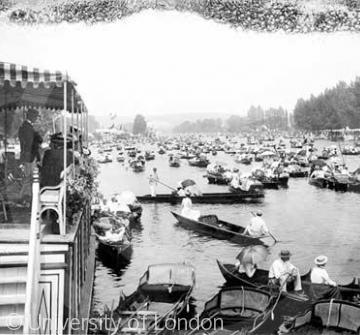Social Life and Entertainment
 A crush of pleasure boats at the 1896 Henley Regatta
A crush of pleasure boats at the 1896 Henley RegattaEnglish communities have always enjoyed a rich social life. Music and drama play an important part in people's lives. As well as the well known local events like the Helston Furry Dance in Cornwall, many communities had their own traditions of dances, sports, maypoles, and mumming.
Medieval social life revolved around church festivals, including church ales, sports and liturgical drama. Mystery plays from York, Chester and Coventry survive but many parishes had a hell's mouth or other props for similar dramas. By the 17th century secular entertainment was found in alehouses and at fairs with plays and puppet shows as well as travelling minstrels who visited country houses at Christmas. Rural parishes marked Gunpowder Plot and Oak Apple Day, military victories and other national events. London and other larger towns began to develop public theatres.
By the later 18th century there were many public performances of music and plays and assembly rooms for dancing. Showmen provided animals, acrobats and freaks for mass entertainment and the travelling circus became an important social event. The 19th century saw the extension of commercial entertainment from readings to melodramas and from oratorios to musical halls. Churches and chapels had halls and choirs and public houses had skittle alleys, pianos and clubrooms. New larger theatres were built such as the Empire at Sunderland. The turn of the century brought film shows.
In the 20th century the cinema was one of the most popular forms of public entertainment and theatres turned into cinemas later closing altogether as radio and television kept people at home but some like the Woolstore at Codford survived. Local carnivals such as those in Somerset, were based on 5 November celebrations or like the St Paul's Carnival, Bristol were organised by new communities. Pageants and festivals of music and the arts were popular as were traditional and modern sporting events from pancake tossing to marathons.









